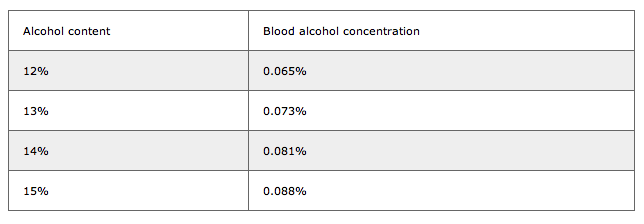“I only had two glasses of wine.”
It’s not an unreasonable amount to drink with dinner, yet how much you feel from those two glasses can vary widely – whether you’re worried about a curbside Breathalyzer or just hoping you don’t feel the effects the next day.
Despite the frequent discussion of rising alcohol levels in wine, the effect on blood alcohol concentration is often overlooked. Does it matter whether you’d been drinking a lean white at 12 percent alcohol instead of a ripe Chardonnay with 14 percent alcohol or a high-octane Zinfandel?
It’s a difficult question to answer because it depends on how you metabolize alcohol – and it’s different for men and women. But, in a word, yes – it most definitely does matter.
Although the liver breaks down most of the alcohol we consume, alcohol metabolism really starts in the stomach, which contains an enzyme called alcohol dehydrogenase, similar to the ones found in the liver. But not all stomachs handle alcohol the same way; gender, age and whether you ate while drinking all help determine how much alcohol is broken down in the stomach before it makes it into the bloodstream.
Women have less of this enzyme than men (or it doesn’t work as well because it might be estrogen sensitive). As a consequence, women break down less alcohol in their stomachs, which means they will have a higher BAC even if they drink the same amount as men. Some scientists believe that the enzyme becomes less functional with age, which might help explain why people become less alcohol-tolerant as they get older.
Alcohol is distributed only in the portion of the body composed of water, as opposed to fat. Since men’s bodies contain a higher proportion of water than women’s, the alcohol is dispersed in a larger volume, which means a man would have a lower blood alcohol despite drinking the same amount as a woman.
The stomach pushes its contents into the small intestine, where most alcohol is absorbed. It empties more slowly when filled with food, so drinking while eating means alcohol stays in the stomach longer, where it can be broken down, resulting in lower blood alcohol levels. So eating before or while drinking – but not after – will result in a lower blood alcohol than drinking on an empty stomach. (As for the urban myth about eating butter before drinking to “protect” the stomach, it’s not true, but it will result in a lower blood alcohol.)
Those who drink wine regularly – one or two glasses a day – will have lower blood alcohol levels than those who drink occasionally. Drinking one to two glasses of wine daily tells the liver to recruit more enzymes – to rev up the factory – to break down alcohol. Everything else being equal, a chronic imbiber will have a lower blood alcohol than a sporadic drinker because the liver has more enzymes ready to break down the alcohol.
Most daily wine drinkers recognize this phenomenon when they have a brief illness, such as a cold, and temporarily stop drinking. After a week of abstinence, the first glass of wine has a bigger impact than usual. After a week of not drinking, the liver is out of practice.
Even if you enjoy wine daily, how fast you drink is important because the slower alcohol is presented to the enzymes – whether they are in the stomach or liver – the more efficient they are in breaking it down before it reaches the bloodstream.
So if you’re a 200-pound male who drinks wine regularly and has just finished two glasses over a two-hour meal, your blood alcohol will be dramatically lower than that of a 130-pound woman who drinks occasionally and has polished off those two glasses quickly.
Still, don’t discount even the small differences in the alcoholic content of what you drink. Obviously, drinking 80-proof spirits can have more impact than drinking an equal amount of wine. But even a 1 to 2 percent variable in the alcoholic content of wine can make a big difference. (See table). When practicing moderation, keep the wine’s alcohol level in mind.
BAC comparison
Does a 14 percent wine really get you more drunk than one at 12 percent? It can. The table below shows the blood alcohol concentration for an average 130-pound woman who consumes two 5-ounce glasses of wine over 1 1/2 hours.
While the alcohol content of the wine rises 25 percent (from 12 to 15 percent), BAC goes up by 35 percent – above California’s legal driving limit of 0.08 percent. As more alcohol hits the stomach, more of it gets through into the blood.
These calculations are rough estimates because the formula does not account for differences in how the liver metabolizes alcohol, so don’t rely on these values or other calculators for determining whether it is safe to drive.
-Michael Apstein

Source: Formula at www.globalrph.com/bac.cgi
This article appeared on page G – 6 of the San Francisco Chronicle on Sunday, August 7, 2011
